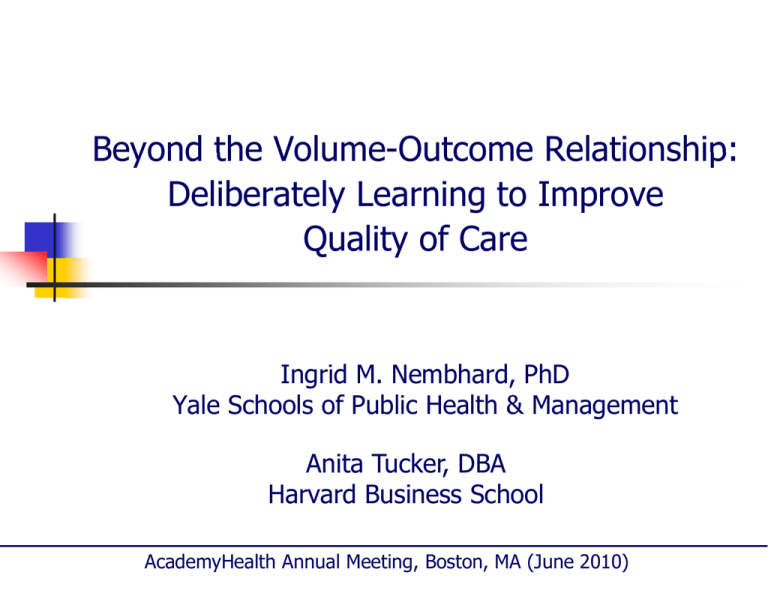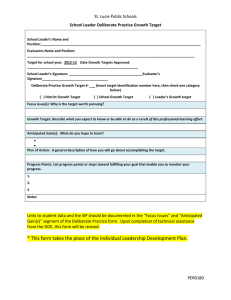Beyond the Volume-Outcome Relationship: Beyond the Volume Outcome Relationship:
advertisement

Beyond the Volume-Outcome Volume Outcome Relationship: Deliberately Learning to Improve Quality of Care IIngrid id M. M Nembhard, N bh d PhD Yale Schools of Public Health & Management Anita Tucker, DBA Harvard Business School AcademyHealth Annual Meeting, Boston, MA (June 2010) The Volume Volume-Outcome Outcome Relationship Ou utcome (e.g., procedu ure time, mortalityy) Learning-by-doing a.k.a. “The Learning Curve” -- Average for X organizations i i 0 5 10 15 20 Volume l (i.e., number of procedures, patients, cases) 2 A motivating puzzle: Significant variation among hospitals Proce edure tim me in hourrs (Adjuste ed for illn ness seve erity) -- Average of 16 hospitals implementing MICS Mountain Medical Center (The Best) Chelsea Hospital 6 What explains hospital variation in improvement rates? 5 4 3 0 5 10 15 20 Number of procedures (Case number) Sources: Pisano, GP., Bohmer RMJ, Edmondson AC. 2001. Organizational Differences in Rates of Learning: Evidence from the Adoption of Minimally Invasive Cardiac Surgery." Management Science; 47(6); Edmondson AC, 3 Bohmer RMJ, Pisano, GP. Speeding Up Team Learning. Harvard Business Review (October 2001 ): 125-132 Explaining organizational differences in i improvement t rates t What didn didn’tt matter: Institution type: All leading academic medical centers and community hospitals, Highly successful in traditional approach to cardiac surgery High-level management support: All had senior management support Project leaders status: All reputable surgeons, some department heads, some senior surgeons, some junior surgeons Training: All went through identical training to use MICS Attempts: All attempted to implement MICS in their organizations Patient characteristics: No discernable differences D Data collection/reporting: ll i / i All produced d d retrospective i summary reports 4 Research question & hypotheses Research q question: Does the use of deliberate learning activities (DLA) offers performance benefits beyond those provided by cumulative volume (i.e., experience)? DLA: deliberate activities to create, acquire, or transfer knowledge, e.g., soliciting staff ideas, dry runs, etc. Hypotheses: Interdisciplinary collaboration Use of deliberate learning activities learning activities H2: (+) H1: (+) Patient outcomes 5 Research methods Setting: Vermont Oxford Network (VON) NIC/Q2002 national collaborative ll b ti to t improve i neonatal t l care (44 NICUs) NICU ) Data a a Sources: Sou es 1. Organizational Assessment Survey (2 parts) 1. 2. 2. Part I – completed by all staff; measured interdisciplinary collaboration Part II – completed by QI teams; measured use of learning activities VON NICU-patient database Sample: 23 NICUs in the United States and Canada (58% response) 1,440 health care professionals (46% response), 265 for Part II 2159 ELBW infants treated in 23 NICUs during study period (‘03-04) Analysis: Logistic regression models with clustering by NICU, RSE 6 Measures Variable Measured by Patient Outcome: Patient Mortality An indicator variable to denote whether each ELBW infant in the NICU lived (1 = lived, 0 = died) C Cumulative l ti Experience E i S Sum off the th number b off infants i f t treated t t d Improvement team members’ report of the use of 7 learning activities (=.88): (= 88): Use of Deliberate Learning Activities Interdisciplinary C ll b ti Collaboration - Solicitation of ideas from staff - Pilot runs Staff feedback before implementation - Dry runs Education sessions with staff - Team meetings Problem-solving cycles (Plan-Do-Study-Act) Nurses’’ and N d respiratory i t th therapists’ i t ’ reported t d llevell off agreement with 6 survey items (=.88) e.g., - “Communication between nurses and physicians is open and positive.” - “The input of respiratory therapists and/or other ancillary staff 7 is regularly sought when developing treatment plans.” Control variables Variables Individual patient-level variables i bl Measured by From risk-adjustment F i k dj t t model d l developed d l d by b the th Vermont V t Oxford Network (Rogowski et al. 2004): gestational age, gestational age squared, gender, small for gestational age, member of multiple birth, vaginal delivery, outborn status, mother’s race, and 1minute Apgar score NICU-level variables (p < .10) 10) teaching status urban location improvement team size average staff tenure (~ staff turnover) prior performance (Standardized Mortality Ratio in 2001) Excluded variables (p > .10) 10) hospital p ownership p status (e.g. ( g for-profit p hospital), p ), number of NICU beds, staff-to-beds ratio, average staff hours worked weekly, percentage of physicians on the improvement team, number of times participated in a collaborative, number of improvement projects during the collaborative, and level of evidence supporting the 8 NICU’s improvement project portfolio Result 1: Deliberate learning activities matters Model 1: All years Model 2: By year DV = Mortality OR RSE p for 2003 infants Cumulative experience 0.97 0.10 Cumulative experience for 2004 infants 0.80* 0.07 D lib t llearning Deliberate i activities ti iti for f 2003 iinfants f t 1 18* 1.18* 0 08 0.08 Deliberate learning activities for 2004 infants 0.82* 0.07 0.84 0.11 Variables Cumulative experience Deliberate learning activities OR 0.93 RSE 0.06 1.01 0.07 Year of infant birth (1 = infant born in 2003) Control variables Urban location 1.19 0.19 1.33* 0.19 Teaching hospital 0.66* 0.12 0.66* 0.12 Improvement team size 0.84** 0.06 0.85* 0.06 Staff tenure 1.20* 0.10 1.18^ 0.10 Prior performance (2001 SMR) 1.29* 0.13 1.28* 0.13 Pseudo R-squared 0.149 0.154 Notes: N = 2159; * p < 0.05; ** p < .01; Infant-level risk adjusters included; clustered by NICUs 9 Result 2: Collaboration does not moderate DV = Mortality OR RSE Cumulative experience 0.94 0.07 Deliberate learning activities 1.14 0.13 Interdisciplinary collaboration 0.76** .07 Deliberate learning activities x Collaboration 1 00 1.00 .08 08 Urban location 1.92** 0.37 Teaching hospital 0.56** 0.12 Improvement team size 0 78** 0.78 0 04 0.04 Staff tenure 1.27** 0.09 Prior performance (2001 SMR) 1.20* 0.10 Variables H2: Not Supported Control variables Pseudo R-squared ^ < 0.10, * p < 0.05; ** p < .01; Infant-level risk adjusters included; 0.155 10 A re-conceptualization: Mediation not Moderation Two possibilities: 1. Interdisciplinary collaboration as a mediator Use of deliberate l learning activities 2. Interdisciplinary Collaboration ll b Patient Outcomes Deliberate learning activities as a mediator Interdisciplinary Collaboration Use of deliberate g learning activities Patient Outcomes 11 Test of M1: I t di i li Interdisciplinary collaboration ll b ti as a mediator di t Mediation Supported Interdisciplinary Collaboration Step 2: B = .21** Use of deliberate Use of deliberate learning activities OR = .82* Step 3: OR = .82* -> 1.03 Step 1: Patient Patient mortality Step 3: ^ < 0.10, * p < 0.05; ** p < .01 ; 2004 data Control variables included: Urban location, teaching hospital, improvement team size, prior12 performance, staff tenure, psychological safety, infant-level risk adjusters Test of M2: Use of DLA as a mediator Use of deliberate learning activities (DLA) Step 2: Interdisciplinary Interdisciplinary collaboration Mediation Not Supported B = -.01 Step 1: OR =.79** Patient Patient mortality ^ < 0.10, * p < 0.05; ** p < .01; 2004 data Control variables included: Urban location, teaching hospital, improvement team size, prior13 performance, staff tenure, psychological safety, infant-level risk adjusters Summary of results: Two paths to high quality care In the long-term: Autonomous Learning: Cumulative experience (e.g., volume) Induced Learning: Use of deliberate learning activities (e.g., dry runs) Patient mortality Interdisciplinary Collaboration 14 Contributions and implications p Validates the systematic study of the deliberate learninglearning outcome relationship Short Short-term term negative relationship suggests the need for extra vigilance during initial phase of use Long-term g positive relationship p p suggests gg alternate strategy gy for outcomes improvement Shows that deliberate learning activities influences interdisciplinary collaboration, a key determinant of quality of care Informs the policy debate: “The Volume-Outcome Conundrum” Use of deliberate learning activities as an equally effective 15 alternative to solve the conundrum long-term? Acknowledgements Collaborators from the Vermont Oxford Network F d Funders Hospitals that participated Jeffrey Horbar, MD (CEO) Joseph Carpenter, MS Harvard Business School Division of Research Wharton’ss Fishman-Davidson Center for Service and Wharton Operations Management Sloan Industry Studies Fellowship Colleagues from Harvard Business School Amy Edmondson, A Ed d PhD Richard Bohmer, MD, MPH 16 THANK YOU! Supplemental Slides The Volume Volume-Outcome Outcome Relationship Volume 301 (25): 1364-1369 1364 1369 December 20, 1979 Should operations be regionalized? The empirical relation between surgical volume and mortality HS Luft Luft, JP Bunker Bunker, and AC Enthoven Abstract This study examines mortality rates for 12 surgical procedures of varying complexity in 1498 hospitals to determine whether there is a relation between a hospital's surgical volume and its surgical mortality. The mortality of open-heart surgery, vascular surgery, transurethral resection of the prostate, and coronary bypass decreased with increasing number of operations. Hospitals in which 200 or more of these operations were done annually had death rates, adjusted for case mix, 25 to 41 per cent lower than hospitals with lower volumes. For other procedures, the mortality curve flattened at lower volumes. For example, hospitals doing 50 to 100 total hip replacements attained a mortality rate for this procedure almost as low as that of hospitals doing 200 or more. Some procedures, such as cholecystectomy, showed no relation between volume and mortality. The results may reflect the effect of volume or experience on mortality, l or referrals f l to institutions with h better b outcomes, as wellll as a number b off other h factors, f such h as patient selection. Regardless of the explanation, these data support the value of regionalization for certain operations. 19 The Volume-Outcome Conundrum The Volume–Outcome Conundrum Kenneth W. Kizer, MD, MPH V l Volume 349 (22) :2159-2161 2159 2161 November 27, 2003 Volume and Outcome – It Is Time to Move Ahead Arnold o M. Epstein, p , MD Volume 346 (15) :1161-1163 April 11, 2002 20 The “Volume-Outcome Volume Outcome Conundrum Conundrum” Implications of the effectiveness of Cumulative Experience Regionalization of care to high-volume institutions Selective purchasing (e.g., Leapfrog Group) Selective referral to high-volume high volume institutions Selective avoidance of low-volume institutions Concerns and challenges Will increased caseload deteriorate performance? Will high-volume providers use market power to inflate costs? Will innovators still be able to enter the market? Will the disruption to the delivery system be too great? What will the impact of lost patients be on financially strained centers? C the Can th opposition iti off hospitals h it l and d physicians h i i be b overcome?? What to do with the low-volume providers? 21 Kizer K. “The Volume-Outcome Conundrum;” and Epstein A. “Volume and Outcome – It Is Time to Move Ahead” NICU Participants v. Non-participants Characteristics Hospital ownership Hospital type Participant (N=23) Non-Participant (N=17) 22 Not-for-profit 1 Government 13 Not-for-profit 1 Government 2 For-profit, F fit 1 Other Oth 17 Teaching 6 Non-teaching Level of care in NICU a, b, c 13 Teaching 4 Non-teaching 2 No major surgery 9 No cardiac surgery 12 All surgeries 2.4 (.7) 0 No major surgery 13 No cardiac surgery 4 All surgeries 2.2 (.4) 8 None 11 one prior 4 two prior .8 (.7) 8 None 7 one prior 2 two prior .7(.7) NICU-OB NICU OB relations, relations Pain and sedation, sedation Infection, Respiratory care, Discharge, Staffing, Family-centered care NICU-OB NICU OB relation, relation Pain and sedation, sedation Infection, Respiratory care, Discharge, Staffing, Family-centered care # of NICU Beds 41.4 (12.2) Not available No. of ELBW babies in 2001 b 45.2 (22.4) 47.6 (29.5) % of babies with APGAR score < 3 33.9 (10.8) 30.8 (10.4) % of babies born outside the NICU 29.5 (33.9) 18.5 (24.6) Babies’ birthweight (grams) 772.6 (29.7) 775.9 (37.2) 26 (.5) 26 (0.7) 74 (12.5) 74.8 (9.5) No of past collaboratives a,, b No. Target Area Gestational age at birth (weeks) a, b, e Length of stay (days) a, b, e 22 Sample: Patient characteristics Variable Mean or % SD Min Max 0 15 0.15 0 36 0.36 0 1 1a. Mortality for 2003 infants (n=1098) 0.15 0.35 0 1 1b. Mortality for 2004 infants (n=1061) 0.16 0.36 0 1 2. Gestational age (weeks) 25.96 2.00 21 35 3. Birthweight (grams) 769.65 146.86 415 1000 g 4. Small for ggestational age 0.16 0.37 0 1 5. 1-minute APGAR score 4.74 2.31 0 9 6. Gender (1 = male) 0.50 0.50 0 1 7. Mother’s h race - White hi 0.60 0.49 0 1 8. Mother’s race - Black 0.23 0.42 0 1 9. Mother’s race - Hispanic 0.10 0.30 0 1 10. Mother’s race - Asian 0.05 0.21 0 1 11. Mother’s race - Other 0.03 0.16 0 1 12 Vaginal 12. V i l delivery d li 0 30 0.30 0 46 0.46 0 1 13. Member of multiple birth 0.27 0.45 0 1 14. Born at another hospital 0.26 0.44 0 1 1 Mortality (2003 and 2004) 1. 23 Sample: NICU characteristics Variable Mean SD Min Max 1. Mortality (2003 & 2004) 0.17 0.06 0.08 0.27 141.33 76.5 21.7 322.3 -0.40^ 3. Deliberate learning activities 3.46 0.47 2.29 4.37 -0.11 -0.11 4. Interdisciplinary collaboration 5 22 5.22 0 60 0.60 4 04 4.04 6 33 6.33 -0.28 0 28 -0.03 0 03 0 30 0.30 5. Urban hospital 0.04 0.21 0.00 1.00 -0.21 0.48* -0.09 0.21 6 Teaching hospital 0.70 0.47 0.00 1.00 -0.09 0.09 -0.23 -0.14 0.14 7. Improvement team size 12.91 6.33 5.00 27.00 -0.42^ 0.28 0.27 -0.10 0.18 -0.25 8. Staff tenure 3.86 0.52 2.89 4.80 0.36^ -0.30 -0.30 0.20 0.01 0.09 -0.30 9. Prior performance (2001 SMR) 0 99 0.99 0 40 0.40 0 39 0.39 1 86 1.86 0 27 0.27 -0 13 -0.13 0 37^ 0.37 -0 15 -0.15 -0 04 -0.04 -0 02 -0.02 0 12 0.12 2. Cumulative experience (2002 2004) (2002-2004) 1 2 3 4 5 6 7 8 -0 23 -0.23 24 Summary: y Staff characteristics Variable Mean S.D. 1 2 3 4 5 6 7 8 1 P 1. Professional f i l status t t - 3 groups: Physicians v. nurses v. therapists 2 03 2.03 .43 43 2. Professional status - 2 groups: High v. v low status .08 .27 .71** 3. Psychological safety 5.31 1.08 .15** .14** 4. Leader inclusiveness 4.62 .55 <.01 -.01 .29** 5. Engagement in quality improvement work 5.45 1.06 .12** .17** .48** .21** 6. Gender 1.10 .30 .23** .56** .05 -.04 .02 7 Y 7. Years iin any NICU§ 4 17 4.17 1 19 1.19 .08** 08** .10** 10** -.05 05 .09** 09** -.03 03 .08** 08** 8. Years as hospital employee§ 3.97 1.26 .03 .01 -.04 .02 -.02 .07* .73** 9. Years in current NICU§ 3.84 1.31 .05 .03 -.04 .02 -.02 .08** .81** .94** 10. Hours per week in NICU 33.84 13.46 .35** .38** .05 -.03 .12** -.06* -.08** § .10** 9 -.08** This is a categorical variable: 1 = less than one year, 2 = one to less than two years, 3 = two to less than five years, 4= five to less than ten years, 5 = ten or more years * p < .05, 05 ** p < .01 01 25 Control Co o variable: a ab e Prior o performance pe o a ce Prior Performance as measured by SMR in 2001 (SMR = Standardized Mortality Ratio) 1. 2. 3. 4 4. Logistic regression model (clustered by NICU) Dependent variable: Morality (1 = lived, 0 = died) Independent variables: Established infant-level risk factors P di t probability Predict b bilit off death d th for f each h baby b b By NICU, sum up probability of death, actual deaths Compute ratio: Actual deaths SMR Mortality Expected deaths SMR < 1 Outcomes BETTER than expected SMR = 1 Outcomes equal to expected SMR > 1 Outcomes O t WORSE than th expected t d 26 Test of M1: U off DLA CollaborationMortality Use C ll b ti M t lit Criterion for mediation being tested Criterion 1 Criterion 2 Criterion 3 Dependent variable Mortality Collaboration Mortality Coefficients reported OR RSE RSE 0.09^ 0.05 OR RSE Variables Cumulative experience Cumulative experience for 2003 infants 0.97 0.10 0.91 0.09 Cumulative experience for 2004 infants 0.80* 0.07 0.79** 0.07 Deliberate learning activities 0.21** 0.07 Deliberate learning activities for 2003 infants 1 18* 1.18 0 08 0.08 1 45** 1.45 0 15 0.15 Deliberate learning activities for 2004 infants 0.82* 0.07 1.03 0.12 0.84 0.11 .81^ 0.09 .82* 0.08 Year of infant birth (1 = 2003) Interdisciplinary collaboration Control variables (all previous) Observations 2159 1081 2159 Pseudo R-squared (R-squared) 0.15 (0.65) 0.16 Mediation Supported 27 Test of M2: Collaboration Use of DLA Mortality Criterion for mediation being tested Criterion 1 Criterion 2 Dependent variable Mortality Deliberate Learn Coefficients reported RSE OR RSE Variables Cumulative experience Cumulative experience for 2003 infants 0.94 0.09 Cumulative experience for 2004 infants 0.84* 0.07 Year of infant birth (1 = 2003) 0.83 0.12 Interdisciplinary collaboration 0.79** 0.07 -0.08 0.07 -0.01 0.12 Deliberate learning activities Deliberate learning activities for 2003 infants Deliberate learning activities for 2004 infants Control variables (all previous) Observations 2159 244 Pseudo R-squared (R-squared) .16 .10 Mediation NOT Supported 28 A qualitative look at deliberate learning Deliberate learning g activities create opportunities pp for all staff to engage in operational and conceptual learning -- while adapting work practices to fit the organizational context Adaptation Learning (via p ) experimentation) Staff involvement “We made our best guess using the [existing bits and pieces of] evidence to figure out how we could implement it in a way that was reasonable for our people people. . . We used the isolation room and a rubber ball to simulate a neonate, and we tried everything. We conducted dry-runs to see what it would be like to try this and that...We that We tried lots and lots of ways, practicing. “We W use this thi procedure d iin the th d delivery li room 100% off the th time. Even now, every once in awhile, someone will say, ‘What if we did this?’ And they suggest a little bit of a modification ” modification. Neonatologist, NICU 3 29 Qualitative support for collaboration as a mediator “We had to change how we worked together as a team, too, because now we had to do things a little differently, so now you needed your buddy to do something a little differently, so you could do something a little differently.” - NICU 3 Respiratory p y Therapist p “We We practiced because this requires a certain amount of dexterity. Now we predefine before we go to delivery who does what job. All of us can do all of the jobs. . . Sometimes Rick and I are back there, and I’ll intubate and he’ll put the surfactant in. Sometimes, he’ll intubate.” - NICU 3 Neonatalogist 30 I Induced Autono omous An unanswered question: Th path The th to t the th use off deliberate d lib t learning l i Cumulative experience (e.g., volume) Leader inclusiveness Psychological safety Deliberate learning activities Patient mortality Interdiscp. Collaboration (e g dry runs) (e.g., LLeader d inclusiveness: i l i l d actions leader ti that th t indicate i di t an invitation i it ti and d appreciation i ti for f others’ contributions Psychological safety: feeling safe to speak up with questions, concerns, suggestions31 Cumulative experience * Collaboration Logistic g regression: g Std. Err. adjusted j for 23 clusters ------------------------------------------------------------------Robust mortality | Odds Ratio Std. Err. 95% Conf. Interval -------------+----------------------------------------------------Cum. experience | .9981499* .0009491 .9962914 1.000012 Deliberate learning | .8684743 .1393244 .6341669 1.189352 Collaboration | .4803655* .1460516 .2647099 .871712 Experience*Collab | .9316546 .1919105 .6221813 1.39506 Urban | 2.417283 1.577743 .6725958 8.687617 Teaching | .4691311** .0838228 .330525 .6658618 T Team size i | .9533597** 9533597** .010311 010311 .9333632 9333632 .973784 973784 Prior performance | 1.841424* .4697671 1.116871 3.036019 Staff tenure | 1.444116* .2368301 1.047147 1.991573 32 Hypothesis 1 Hypothesis The use of DLA is positively associated with better patient outcomes, after accounting for the benefit of cumulative experience. experience R ti Rationale: l DLA helps h l overcome 3 challenges: h ll Rapid knowledge growth -> limited ability to draw on past Variability and uncertainty ->unable to gain experience Errors may cause harm -> low motivation to change Use of deliberate Use of deliberate learning activities H1 Patient Patient outcomes 33 Hypothesis 2: Th moderating The d ti effect ff t off collaboration ll b ti Hypothesis: yp The p positive relationship p between use of DLA and patient outcomes will be stronger in g p with greater g collaboration. workgroups Why collaboration might matter: It leads to: Better decision-making (Milliken and Martins 1996) Better coordination (Gittell 2002) Better error detection and recovery (Weick et al. 1999) Interdisciplinary collaboration Use of deliberate Use of deliberate learning activities H2 Patient Patient outcomes 34 Research question Does the use of deliberate learning activities (DLA) account for differences in outcomes improvement? DLA defined: deliberate activities to create create, acquire, or transfer knowledge, e.g., soliciting staff ideas ideas, dry runs runs, etc etc. 35 Research objective examine whether the use of deliberate learning activities (DLA) offers performance benefits beyond those provided byy cumulative volume ((i.e.,, experience) p ) DLA: deliberate activities to create, acquire, or transfer knowledge, e.g., soliciting staff ideas, dry runs, etc. assess whether the effectiveness of deliberate learning activities i i i depends d d on a critical i i l interaction i i in i workgroups, k interdisciplinary collaboration. Interdisciplinary collaboration Use of deliberate Patient H2 learning activities learning activities outcomes H1 36 Hypotheses Hypothesis 1: The use of DLA is positively associated with better patient outcomes, after accounting for the benefit of cumulative experience. p Hypothesis 2: The positive relationship between use of DLA and patient outcomes will be stronger in workgroups with greater collaboration. Interdisciplinary collaboration Use of deliberate learning activities learning activities H2 H1 Patient outcomes 37




